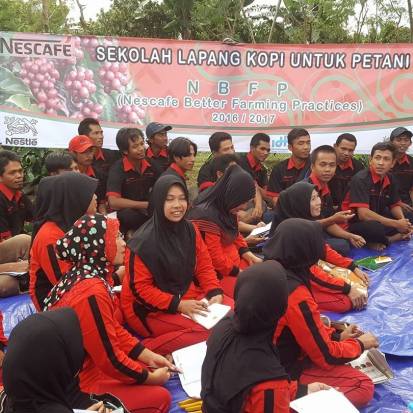PISAgro News, May 2017, Issue No 15, pp. 2-4
By Fitrian Ardiansyah, Indonesia country director of IDH-Sustainable Trade Initiative
Original link: http://pisagro.org/images/uploadsfiles/FA-PISAGRO-Newsletter%2315-May’16.pdf

Given the fact that most of the 40 million workers in the agriculture sector are small farmers, and they are facing with recurrent challenges of low levels of productivity and profitability due to a lack of access to market and financing, the notion of strengthening farmer organizations has become imperative.
Reaching sustainable agriculture goals, comprising improved productivity, protection of the surrounding ecosystems and ensured welfare of farmers, is challenging unless farmers’ capacity and knowledge on good agricultural practices are improved. Such improvement is difficult to be facilitated without strong farmer organizations.
IDH-Sustainable Trade Initiative, in collaboration with partners, believe that innovations in supply chain sustainability require professional farming practices. Our approaches and pilots have shown that such farming practices can only be applied if strong farmer organizations are at the heart of our sustainable business model and values.
In our coffee program, with PT Asal Jaya(1) in Malang for example, efforts to strengthen farmer organizations is considered as a key intervention. These efforts focus on providing institutional support that will lead to the development of Sustainable Agriculture Business Cluster (SABC).
When different farmer organizations are aggregated further into an SABC, they will be perceived to be having an economic of scale. Such scale would help them access finance from financial institutions (FIs). They can also easily sell coffee bean in a bulk way with a relatively better price and as trade-off, receive good agriculture practices (GAPs) and good management practices (GMPs) including accounting system literacy from the company and organizations like IDH.
This type of aggregated farmer organizations would provide a greater opportunity for farmers to get support from off-takers or other organizations to secure legal entity over their lands. Off-takers would see an increased credibility of such organizations and reduced risks in investing in these farmers. As many have known, without legal entity, farmers would have difficulty in getting a deal or financial support from banks.
The presence of good farmer organizations with the support of off-takers and other organizations can help farmers gradually demonstrate that they can improve or have improved their practices shown by results over a particular period. In a good farmer organization, documentation of farming process and accounting system is usually the norm.
Strengthening farmer organizations, nevertheless, is not an easy task. Often farmers are unwilling to be grouped in an organization such as a cooperative. Innovation or slightly different approach is sometime required.
As an example, in our palm oil program in North Sumatra, working with a state-owned company(2), a different model for farmer organizations has been introduced to support farmers to achieve Roundtable on Sustainable Palm Oil (RSPO) certification. The difference is that the organizations still consist of farmer groups (kelompok petani) but managed by traders.
This slightly different approach is chosen due to the fact that traders have many farmers under their wings (approximately several hundreds) and this has been perceived as a way to scale up the coverage of farmers in a sustainable supply chain of palm oil. In addition, with traders’ involvement and their staff in supporting farmers, they can also be seen as some forms of extension services, not only connecting farmers to the supply chain but also providing concrete support in forms of GAPs.
A similar approach has been done with Asian Agri(3) in Jambi, in which farmer organizations are supported through traders. In this case, traders are trained so that they can further help and reach out farmers with GAPs and GMPs. With the increased capacity of traders, they also are gradually equipped with good capacity in taking bigger responsibility in this sustainable supply chain.
A traditional type of farmer organizations such as cooperatives (e.g. Koperasi Unit Desa or KUD), nevertheless, is still crucial since KUD or a similar organization exist in almost every kabupaten (district) in Indonesia. For this reason, IDH also works with different corporate partners to show that strengthening KUD can bring about better benefit for farmers. The recent initiative in South Sumatra with IndoAgri London Sumatra shows that KUD can also be a good platform for palm oil farmers to achieve RSPO certification.
Farmer organizations and aggregation or clustering, to a large extent, can help farmers to increase their economic scale. Such “clustering”, however, needs to be done with tailor-made services, so that choices are also created for farmers since different types of farmers may require a different type of approaches and clusters.
One key lesson-learned in establishing such cluster is, at least, a principle of open and transparent farmer organizations should be upheld. This is critical so small farmers will see such organizations as a fair and just platform and can support their agenda of improved productivity and sustainability – not only the agenda of off-takers or traders.
The presence of strong and credible farmer organizations will not only provide a vehicle for improved productivity for farmers in a relatively scalable level, but also can be used to support farmers in promoting the agenda of environmental protection in a significant way.
Encroachment and conversion of forests and peat – and cultivating using fires – have been perceived as challenging issues when it comes to small farmers and deforestation and environmental protection. A good farmer organization can, to some extent, be an umbrella that develop a treaty or agreement for conservation of the remaining or surrounding forest and peat, equipped further with a good plan, investment and monitoring system.
Examples of fire-free villages – a joint-work between companies and villages to address forest and land fires across Indonesia – can be used to show that with an organization of villagers or farmers, actions to address (prevent or mitigate) fires are much easier to apply. Without clear farmer or villager organizations, a company, donor agency or government would have difficulty in pushing the agenda of fire prevention or other environmental protection.
In brief, the presence of strong, credible and accountable farmer organizations has become a necessity in sustainable agriculture. Such organizations would help farmers to develop a good business case at farmer level, improved provision of service delivery or extension services, and increase access to adequate and sufficient finance.
The immediate next step, as often the case, is to replicate, magnify and scale up models of good farmer organizations. PISAgro and its members, in this case, have the opportunity to transform such models into larger applicable platforms across Indonesia and in variety of commodities.
Endnote:
- The IDH’s work with PT Asal Jaya is entitled The Ecosystem Chain Scale in a Sustainable Coffee Smallholder Business in East Java. The period of work is between January 2016 to December 2020, targeting 15,000 farmers. Currently, around 3,400 farmers are part of the program. The focus of the program is to support farmer organizations, GAP and GMP practices, and farmers driven research.
- The work is with PTPN 3 with approximately 600 farmers to be supported but 59 will be certified soon under RSPO.
- The initial target of the work with Asian Agri is to support 10,000 farmers and now 6,000 farmers (around 30,000 ha) are part of the program. The program focuses interventions that can be categorized as “beyond certification” approach (not only aiming to achieve certification).



